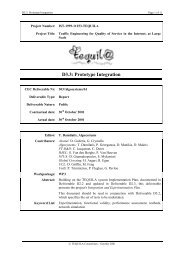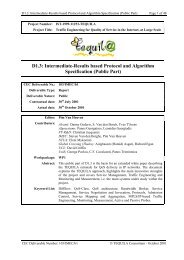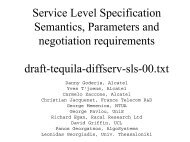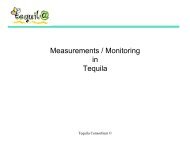An Architectural Framework for Providing QoS in IP ... - ist tequila
An Architectural Framework for Providing QoS in IP ... - ist tequila
An Architectural Framework for Providing QoS in IP ... - ist tequila
You also want an ePaper? Increase the reach of your titles
YUMPU automatically turns print PDFs into web optimized ePapers that Google loves.
<strong>An</strong> <strong>Architectural</strong> <strong>Framework</strong> <strong>for</strong><br />
<strong>Provid<strong>in</strong>g</strong> <strong>QoS</strong> <strong>in</strong> <strong>IP</strong> Differentiated<br />
Services Networks<br />
P.Trim<strong>in</strong>tzios, I. <strong>An</strong>drikopoulos, G. Pavlou, C.F. Cavalcanti,<br />
D. Goderis, Y. T’Joens, P. Georgatsos, L. Georgiadis,<br />
D. Griff<strong>in</strong>, R. Egan, C. Jacquenet, G. Memenios<br />
Presented by Panos Trim<strong>in</strong>tzios<br />
IM 2001<br />
14-18.5.01<br />
Seattle, WA<br />
USA<br />
Centre <strong>for</strong> Communication Systems Research<br />
School of Electronic Eng<strong>in</strong>eer<strong>in</strong>g and In<strong>for</strong>mation Technology<br />
University of Surrey, UK
Presentation Outl<strong>in</strong>e<br />
Introduction and Objectives<br />
Service Level Specifications (SLSs)<br />
• Contents and Semantics<br />
Functional Architecture<br />
SLS Management<br />
Traffic Eng<strong>in</strong>eer<strong>in</strong>g<br />
Policy Management<br />
Summary<br />
IM 2001<br />
14-18.5.01<br />
Seattle, WA<br />
USA
Introduction<br />
The Internet evolves towards the global multiservice<br />
network of the future<br />
• Support <strong>for</strong> end-to-end (e2e) <strong>QoS</strong> guarantees<br />
Need <strong>for</strong> scalable <strong>QoS</strong> solutions<br />
Differentiated Services (DiffServ)<br />
• Classify, mark and police at the edges<br />
• Limited per-hop behaviours (PHBs)<br />
• Schedul<strong>in</strong>g discipl<strong>in</strong>es, buffer management<br />
• Per-aggregate state <strong>in</strong><strong>for</strong>mation<br />
Traffic Eng<strong>in</strong>eer<strong>in</strong>g<br />
• Control the manner traffic is treated<br />
• User and network-oriented objectives<br />
IM 2001<br />
14-18.5.01<br />
Seattle, WA<br />
USA
Objectives<br />
Current proposals focus on control and data<br />
plane mechanisms. Management plane<br />
• Bandwidth Broker (BB)<br />
Specify the contents and semantics of SLSs<br />
• Reflect the elemental <strong>QoS</strong>-based services<br />
Develop an architecture <strong>for</strong> enabl<strong>in</strong>g<br />
negotiation, monitor<strong>in</strong>g and en<strong>for</strong>cement of<br />
SLSs between customer/ISP and ISP/ISP<br />
Develop a model of co-operat<strong>in</strong>g components,<br />
algorithms and protocols offer<strong>in</strong>g a BB solution<br />
<strong>for</strong> fulfill<strong>in</strong>g the contracted SLSs, while<br />
cont<strong>in</strong>uously optimiz<strong>in</strong>g use of network resources<br />
IM 2001<br />
14-18.5.01<br />
Seattle, WA<br />
USA
SLS Contents and Semantics<br />
<strong>IP</strong> Flow - stream of <strong>IP</strong> packets shar<strong>in</strong>g at least<br />
one common character<strong>ist</strong>ic (WHAT)<br />
• Source, Dest<strong>in</strong>ation, Application, DSCP <strong>in</strong>fo<br />
Scope - the geographical limits over which the<br />
SLS is to be en<strong>for</strong>ced (WHERE)<br />
• Support <strong>for</strong> pipe, hose and funnel models<br />
Traffic Envelope - set of (con<strong>for</strong>mance)<br />
parameters describ<strong>in</strong>g HOW the packet stream<br />
should look like to get per<strong>for</strong>mance guarantees<br />
Traffic Con<strong>for</strong>mance test<strong>in</strong>g - set of actions<br />
<strong>for</strong> identify<strong>in</strong>g <strong>in</strong>- and out-of-profile packets<br />
IM 2001<br />
14-18.5.01<br />
Seattle, WA<br />
USA
SLS Contents and Semantics (cont’d)<br />
Excess Treatment - how the out-of-profile<br />
traffic is treated<br />
• drop, shape, remark<br />
Per<strong>for</strong>mance guarantees - describe the<br />
transport guarantees the network offers to the<br />
customer<br />
• throughput, loss, delay, jitter<br />
Service Schedule –<strong>in</strong>dicatesWHEN the SLS is<br />
active<br />
• Start and end time<br />
Reliability – <strong>in</strong>dicates the level of SLS assurance<br />
• mean downtime per year, maximum time to repair<br />
IM 2001<br />
14-18.5.01<br />
Seattle, WA<br />
USA
Def<strong>in</strong><strong>in</strong>g <strong>IP</strong> Transport Services<br />
The proposed SLSs constitute the elemental<br />
blocks <strong>for</strong> def<strong>in</strong><strong>in</strong>g services<br />
• Unidirectional<br />
• Not necessary to quantify all the parameters<br />
• Also quantification us<strong>in</strong>g relative values (e.g. <strong>for</strong><br />
def<strong>in</strong><strong>in</strong>g Olympic services)<br />
Providers can choose to offer only certa<strong>in</strong><br />
predef<strong>in</strong>ed SLSs<br />
• By us<strong>in</strong>g limited pre-def<strong>in</strong>ed (ranges of) values<br />
More complex services can be def<strong>in</strong>ed, e.g.<br />
• Bi-directional Virtual leased l<strong>in</strong>es (2 pipe SLSs)<br />
• Virtual Private Networks (comb<strong>in</strong>ation of multiple<br />
hose and funnel SLSs)<br />
IM 2001<br />
14-18.5.01<br />
Seattle, WA<br />
USA
Functional Architecture <strong>for</strong> Support<strong>in</strong>g <strong>QoS</strong><br />
SLS Management<br />
Policy Management<br />
Data Plane<br />
Traffic Eng<strong>in</strong>eer<strong>in</strong>g<br />
Monitor<strong>in</strong>g<br />
IM 2001<br />
14-18.5.01<br />
Seattle, WA<br />
USA
Functional Architecture: Fulfill<strong>in</strong>g the SLSs<br />
SLSs<br />
Policy Management<br />
Customer/User<br />
SLS Management<br />
Traffic Eng<strong>in</strong>eer<strong>in</strong>g<br />
Monitor<strong>in</strong>g<br />
Data Plane<br />
IM 2001<br />
14-18.5.01<br />
Seattle, WA<br />
USA<br />
Service description and<br />
negotiation through SLSs<br />
(per-)Customer awareness<br />
Service provision<strong>in</strong>g<br />
through Traffic Eng<strong>in</strong>eer<strong>in</strong>g<br />
(per-)Class awareness
SLS Management<br />
SLS Management Policy Management<br />
SLS Management<br />
SLS<br />
Subscription<br />
Traffic Forecast<br />
SLS Invocation<br />
Traffic Eng<strong>in</strong>eer<strong>in</strong>g<br />
IM 2001<br />
14-18.5.01<br />
Seattle, WA<br />
USA<br />
Data Plane<br />
Monitor<strong>in</strong>g
SLS Management (cont’d)<br />
<br />
<br />
<br />
SLS Subscription between Customer-Provider<br />
• Customer reg<strong>ist</strong>ration and long-term policy-based<br />
admission control<br />
• Negotiat<strong>in</strong>g the right to later <strong>in</strong>voke SLSs<br />
• Allows the provider to provision the network<br />
SLS Invocation between User-Provider<br />
• Dynamic (per-flow) admission control based on:<br />
• the subscribed/provisioned SLSs<br />
• traffic measurements<br />
Traffic Forecast provides the estimated traffic matrix<br />
• Based on subscribed SLSs, measurements and (oversubscription/bus<strong>in</strong>ess)<br />
policies<br />
• Ties the customer- and resource-oriented parts<br />
IM 2001<br />
14-18.5.01<br />
Seattle, WA<br />
USA
Traffic Eng<strong>in</strong>eer<strong>in</strong>g<br />
Policy Management<br />
SLS Management<br />
Network<br />
Dimension<strong>in</strong>g<br />
Dynamic Route<br />
Traffic Management Eng<strong>in</strong>eer<strong>in</strong>g<br />
Data Plane<br />
Dynamic<br />
Resource<br />
Management<br />
Monitor<strong>in</strong>g<br />
Traffic Eng<strong>in</strong>eer<strong>in</strong>g<br />
IM 2001<br />
14-18.5.01<br />
Seattle, WA<br />
USA
Traffic Eng<strong>in</strong>eer<strong>in</strong>g (cont’d)<br />
Two Traffic Eng<strong>in</strong>eer<strong>in</strong>g approaches:<br />
• Explicit routed path based<br />
• Multi-Protocol Label Switch<strong>in</strong>g (MPLS)<br />
• Node-by-node based<br />
• Open Shortest Path First (OSPF)<br />
Operation timescales<br />
• Long-term (days)<br />
• Network Dimension<strong>in</strong>g<br />
• Short-term (m<strong>in</strong>utes)<br />
• Dynamic Route and Resource Management<br />
IM 2001<br />
14-18.5.01<br />
Seattle, WA<br />
USA
Traffic Eng<strong>in</strong>eer<strong>in</strong>g (cont’d)<br />
Network Dimension<strong>in</strong>g<br />
• Input: network topology, traffic <strong>for</strong>ecast, policies<br />
• Objective: optimisation problem<br />
• Ma<strong>in</strong>ta<strong>in</strong> low l<strong>in</strong>k cost while satisfy<strong>in</strong>g <strong>QoS</strong> objectives<br />
• Output <strong>in</strong> the <strong>for</strong>m of configuration directives:<br />
• Explicitly routed paths (MPLS-based)<br />
• Values <strong>for</strong> the l<strong>in</strong>k cost metrics (<strong>IP</strong>-based)<br />
• Per-queue range of requirements<br />
Dynamic Route Management (DRtM)<br />
• Multi-path load d<strong>ist</strong>ribution<br />
Dynamic Resource Management (DRsM)<br />
• Configures PHBs<br />
• Per<strong>for</strong>ms dynamic l<strong>in</strong>k partition<strong>in</strong>g<br />
IM 2001<br />
14-18.5.01<br />
Seattle, WA<br />
USA
Policy Management<br />
Policy Management<br />
Policy<br />
Management<br />
Tool<br />
SLS Management<br />
Policy Management<br />
Policy Stor<strong>in</strong>g<br />
Service<br />
Policy Consumer<br />
Policy Consumer<br />
Policy Consumer<br />
Traffic Eng<strong>in</strong>eer<strong>in</strong>g<br />
IM 2001<br />
14-18.5.01<br />
Seattle, WA<br />
USA<br />
Data Plane<br />
Monitor<strong>in</strong>g
Policy Management (cont’d)<br />
Policy Consumer<br />
• Policy <strong>in</strong>terpretation and en<strong>for</strong>cement<br />
• Many <strong>in</strong>stances, collocated with:<br />
• SLS Subscription, SLS Invocation, Traffic Forecast,<br />
Network Dimension<strong>in</strong>g, DRtM, DRsM<br />
Policy ref<strong>in</strong>ement and hierarchical decomposition<br />
• High-level policies ref<strong>in</strong>ed to reflect the hierarchical<br />
management architecture<br />
• Targets: managed objects of the associated component<br />
or one level below<br />
• The adm<strong>in</strong><strong>ist</strong>rator def<strong>in</strong>es of classes of policies and<br />
ref<strong>in</strong>ement logic/rules<br />
• Automated decomposition of <strong>in</strong>stances of policy<br />
classes<br />
IM 2001<br />
14-18.5.01<br />
Seattle, WA<br />
USA
Functional Architecture: Detailed View<br />
Policy Management<br />
Policy M.<br />
Tool<br />
Policy<br />
Consumer.<br />
Policy Stor<strong>in</strong>g.<br />
Service<br />
SLS Management<br />
SLS<br />
Subscription<br />
Traffic<br />
Forecast<br />
Network<br />
Dimension<strong>in</strong>g<br />
SLS<br />
Invocation<br />
SLS<br />
Monitor<strong>in</strong>g<br />
Network<br />
Monitor<strong>in</strong>g<br />
Dynamic<br />
Route M.<br />
Traffic Eng<strong>in</strong>eer<strong>in</strong>g<br />
Node<br />
Monitor<strong>in</strong>g<br />
Dynamic<br />
Resource M.<br />
Monitor<strong>in</strong>g<br />
IM 2001<br />
14-18.5.01<br />
Seattle, WA<br />
USA<br />
Traffic<br />
Condition<strong>in</strong>g<br />
Data Plane Rout<strong>in</strong>g.<br />
PHB<br />
En<strong>for</strong>cement
Summary<br />
Def<strong>in</strong>ition of an architecture <strong>for</strong> DiffServbased<br />
<strong>IP</strong> <strong>QoS</strong><br />
Proposed SLS content and semantics<br />
• IETF drafts<br />
Policy-driven SLS Management and Traffic<br />
Eng<strong>in</strong>eer<strong>in</strong>g<br />
Detailed design of algorithms and protocols<br />
System currently be<strong>in</strong>g realised<br />
Validation both through simulation and<br />
testbed experimentation<br />
Work done <strong>in</strong> the European project TEQUILA<br />
IM 2001<br />
14-18.5.01<br />
Seattle, WA<br />
USA
ΤΕQUILA: Traffic Eng<strong>in</strong>eer<strong>in</strong>g <strong>for</strong> QUality<br />
of service <strong>in</strong> the Internet at LArge scale<br />
Partners:<br />
Alcatel, France Telecom, Algonet, Global Cross<strong>in</strong>g,<br />
University of Surrey, University College London,<br />
University of Ghent, National Technical University<br />
of Athens<br />
IM 2001<br />
14-18.5.01<br />
Seattle, WA<br />
USA<br />
For more <strong>in</strong><strong>for</strong>mation visit:<br />
http://www.<strong>ist</strong>-<strong>tequila</strong>.org
Virtual<br />
Leased L<strong>in</strong>e<br />
Service<br />
Bandwidth Pipe<br />
<strong>for</strong> Data Services<br />
M<strong>in</strong>imum<br />
Rate<br />
Guaranteed<br />
Service<br />
It could be<br />
used <strong>for</strong> a<br />
bulk of ftp<br />
traffic, or<br />
adaptive video<br />
with m<strong>in</strong><br />
throughput<br />
requirements<br />
Qualitative Olympic<br />
Services<br />
The Funnel<br />
Service<br />
Comments Example of a<br />
unidirectional<br />
VLL, with<br />
Service with only<br />
strict throughput<br />
guarantee. TC and<br />
ET are not<br />
They are meant to<br />
qualitatively differentiate<br />
between applications such<br />
as:<br />
It is primarily a<br />
protection<br />
service; it<br />
restricts the<br />
quantitative<br />
guarantees<br />
def<strong>in</strong>ed but the<br />
operator might<br />
def<strong>in</strong>e one to use<br />
<strong>for</strong> protection.<br />
on-l<strong>in</strong>e<br />
webbrows<strong>in</strong>g<br />
e-mail traffic amount of traffic<br />
enter<strong>in</strong>g a<br />
customer’s<br />
network<br />
Scope (1|1) (1|1) (1|1) (1|1) or (1|N) (N|1) or (all|1)<br />
Flow<br />
Descriptor<br />
EF, S-D <strong>IP</strong>-A S-D <strong>IP</strong>-A AF1x MBI<br />
AF1x<br />
Traffic<br />
Descriptor<br />
Excess<br />
Treatment<br />
Per<strong>for</strong>mance<br />
Parameters<br />
Service<br />
Schedule<br />
Reliability<br />
(b, r) e.g. r=1 NA (b, r) (b, r), r <strong>in</strong>dicates a m<strong>in</strong>imum (b, r)<br />
committed Olympic rate<br />
Dropp<strong>in</strong>g NA Remark<strong>in</strong>g Remark<strong>in</strong>g Dropp<strong>in</strong>g<br />
D =20 (t=5,<br />
q=10e-3),<br />
L=0<br />
(i.e. R = r)<br />
MBI, e.g.<br />
daily 9:00-<br />
17:00<br />
MBI, e.g.<br />
MDT = 2<br />
days<br />
R = 1 R = r D=low<br />
L=low<br />
(gold/green)<br />
D=med<br />
L=low<br />
(silver/green)<br />
NA<br />
MBI MBI MBI MBI MBI<br />
MBI MBI MBI MBI MBI<br />
IM 2001<br />
14-18.5.01<br />
Seattle, WA<br />
USA









